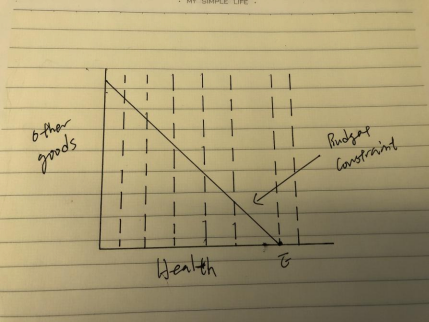ECON 3451 Health Economics Assignment 2
Hello, dear friend, you can consult us at any time if you have any questions, add WeChat: daixieit
ECON 3451 Health Economics
Assignment 2
Instructions: Complete the short answer questions from Chapters 7 and 9 in the textbook. Answer the questions and please submit it in HuskyCT. Submission Options: you could type in word or take a picture of your hand-written answers to submit.
1. (20 pts) FGS 7.2 - Suppose that no amount of other goods can compensate for a loss in health. How would the individual’s indifference curves look? Is this a reasonable assumption in terms of what we actually see taking place?

2. (20 pts) FGS 7.4 - Suppose that John could work 365 days per year and could earn $200 per day for each day he worked. Draw his budget line with respect to his labor–leisure choice.
We have a straight line, with the X intercept of 365 and the Y intercept of 73000. The slope is - 200.
3. (20 pts) FGS 7.5 - Suppose that John chooses to work 200 days per year. Draw the appropriate indifference curve, and note his equilibrium wage income and labor–leisure choices.
Indifference curve is tangent at Leisure = 165, inc e = 40000.
4. (20 pts) FGS 9.3 - Consider the following information on Alfred’s demand for visits per year to his health clinic, if his health insurance does not cover (100 percent coinsurance) clinic visits.
(a) Alfred has been paying $30 per visit. How many visits does he make per year? Draw his demand curve.
Before insurance, Alfred will consume 6 visits at P = $30. After insurance Alfred will consume 9 visits, up to a price of $37.50; (0.4 x $37.50 = 15).
(b) What happens to his demand curve if the insurance company institutes a 40 percent coinsurance feature (Alfred pays 40 percent of the price of each visit)? What is his new equilibrium quantity?

Above $37.50, he will reduce quantity. For example, at P = $50, Alfred's cost is $20, so that he will make 8 visits. .
5. (20 pts) FGS 9.5 - If the price elasticity of demand is -0.5 and the income elasticity is +0.3, then what will be the effect of a simultaneous 10 percent increase in price and a 10 percent increase in income on health expenditures?
A 2% decrease in decrease in quantity, and approximately an 8% increase in health expenditures.
2024-01-05